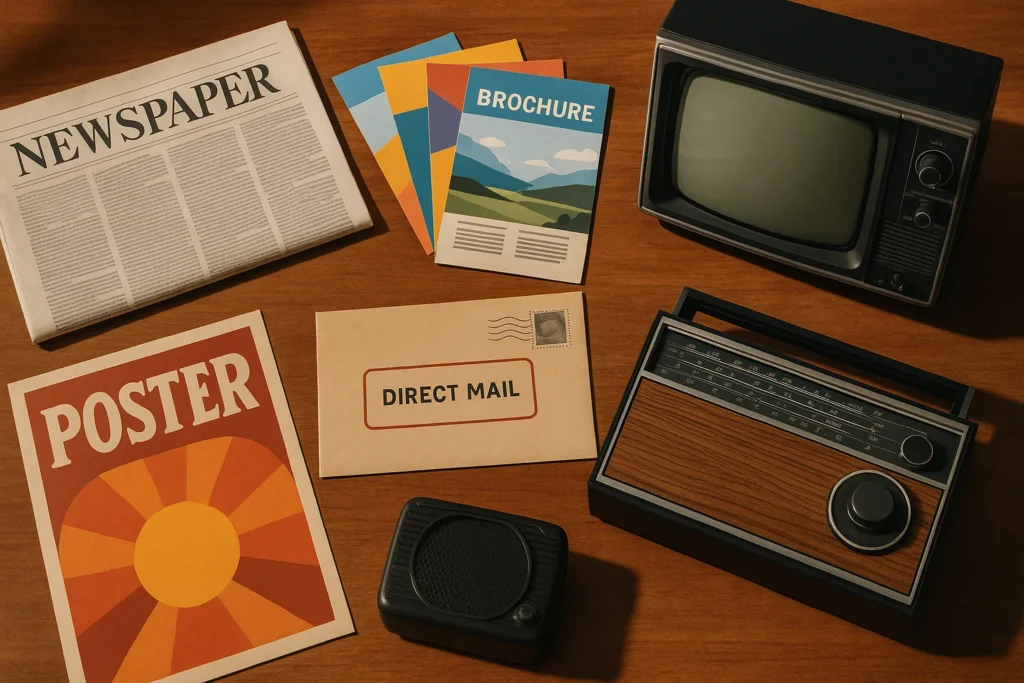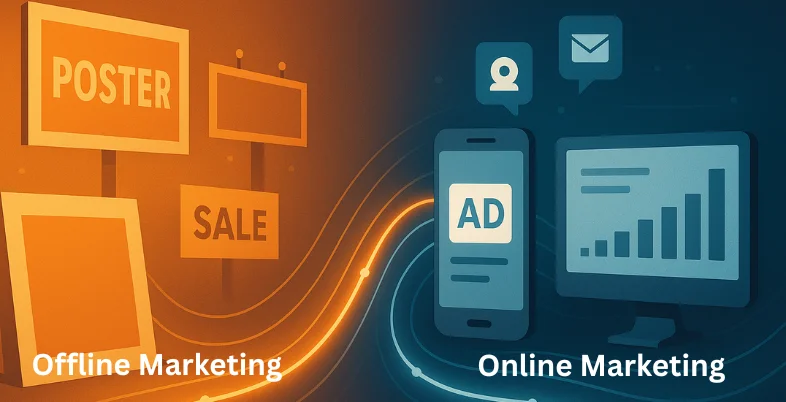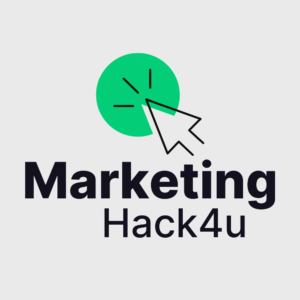Marketing isn’t what it used to be. That’s not a bad thing.
Today, a flyer or a billboard isn’t the final word on brand engagement. And a digital campaign doesn’t live solely in the cloud. Businesses are learning that success comes when offline and online tactics work together. It’s not either-or—it’s both.
Let’s dive into how traditional marketing materials like brochures, business cards, and banners can boost your digital efforts. And yes, we’ll show you how to track it all, too.
Why Integration Matters
According to QRCode Tiger, the digital marketing industry is expected to hit $1.5 trillion by 2030. But don’t write off physical marketing yet—offline marketing is projected to grow to $697 billion in the same timeframe.
So, why not have your cake and eat it too?
Integrating offline and online efforts means you can:
- Build brand consistency
- Extend campaign reach
- Engage customers at multiple touchpoints using powerful customer engagement tools.
- Gather more diverse data
The best part? Integrated campaigns often perform better than isolated ones. Unified messaging across multiple channels creates familiarity, which builds trust.
Integration also encourages businesses to take a step back and think holistically about the customer journey. Instead of thinking in silos, marketers can map out how someone moves from a billboard to an Instagram profile, and then into a shopping cart.
And from a budget perspective, a hybrid approach allows for smarter allocation. You can use digital metrics to measure the impact of offline campaigns, ensuring every printed piece works harder and smarter.
Make Print Interactive
A static flyer isn’t static anymore. Thanks to QR codes and short URLs, your printed piece can drive people straight to your landing page, Instagram Reel, or product page.
Use QR Codes Wisely
QR code usage surged 443% from 2021 to 2022. And 57% of consumers use QR codes daily. That’s not a trend—it’s a habit.
- Put a QR code on your business card that links to your calendar
- Add one to a product brochure that launches a video demo
- Place them on event posters to direct users to the registration page
And always test them first. Nothing kills momentum like a broken link.
You can even generate QR codes and track which ones get the most scans, adjusting future campaigns accordingly. Are people engaging with your brochure more than your event poster? That’s valuable insight.
Also, think beyond just web pages. Link to surveys, feedback forms, or loyalty programs to make your physical handouts part of your CRM pipeline.
Sync Your Branding
One logo. One voice. Many formats.
According to Semantics Scholar, effective integration hinges on synchronized branding and messaging. Your business card should reflect your website. Your flyer should echo your email campaign. That includes fonts, colors, tone, and even your CTA.
It goes deeper than design:
- Align team training so customer service mirrors your marketing
- Deliver consistent messaging in social captions and store signage
- Match offers across platforms (no print-only discounts!)
Brand consistency builds recognition, and recognition builds trust. If your tone is playful on Instagram, it should be just as approachable in your event signage. You can make that happen with fully customizable digital signage templates that let you match tone, colors, and messaging across every screen.
Even the small details matter—like using the same tagline across a print ad and your email footer. Every repetition reinforces memory.
Tap Into Traditional Marketing Formats

Just because a material is traditional doesn’t mean it’s outdated. These formats can add weight—literally and metaphorically—to your digital push.
1. Flyers & Brochures
Use them to promote a webinar or downloadable guide. Just include a QR code or short URL.
They’re great leave-behinds at conferences or community centers. When designed well, people hang onto them—and that’s a second chance for them to take digital action.
Plus, you can use dynamic QR codes that allow you to change the landing page even after printing. This gives you flexibility if your online campaign shifts mid-stream.
2. Business Cards
Use tools like NFC-enabled cards or QR codes to drive people to your portfolio, LinkedIn, or a special landing page.
Don’t underestimate the power of a good card. Handing someone a sleek, scannable card still makes a lasting impression. It bridges professionalism with innovation.
And if you collect business cards at events, follow up with a personalized digital message referencing your conversation—it’s a small touch that stands out. Now that we have advanced in technology, digital business cards are the thing, with which you can easily share your contact without a hassle. Uniqode’s business cards is one of the top tools to give you access to a plethora of tools to customize your card and make it stand out in crowd.
3. Banners
Custom community banners can be great tools to drive local traffic to your digital channels. A well-placed banner at a school or community event can direct people to your social media with a simple hashtag or QR scan.
Banners also act as passive reminders. A bold URL or campaign hashtag in a high-traffic area can spark curiosity and clicks over time.
Be sure to monitor social mentions and search behavior linked to your banner phrasing. That way, you’ll know what’s resonating.
Email Meets Handshake
Here’s a thought: combine the oldest form of marketing—word of mouth—with the most targeted—email.
- Collect emails at physical events using tablets or forms
- Hand out physical coupons that require email activation
- Send follow-up emails to trade show attendees with personalized offers
This isn’t just good marketing. It’s good relationship building.
Don’t forget the power of segmentation. Tag these contacts by event or location so your next email can be even more tailored.
Also, include physical sign-up options in-store with small incentives. A discount for your email can be the nudge someone needs.
Track Everything (Yes, Even Paper)

The biggest challenge in integrating channels? Data.
As All Multidisciplinary Journal explains, businesses struggle with fragmented data systems. When online and offline data live in silos, it’s tough to see what’s working.
Here’s how to bridge that gap:
- Use unique QR codes for different materials to track which channel drove traffic
- Create campaign-specific URLs to identify the print source
- Leverage omnichannel analytics tools to unify your reporting
According to the same journal, companies using integrated analytics report higher ROI and more efficient campaigns.
Even something simple—like using Google Analytics UTM parameters—can provide insight into which flyer or event drove the click.
Consider using CRM platforms that allow offline inputs. This way, you can track touchpoints from printed invites or phone RSVPs in one place.
Measure Online Impact from Offline Triggers
Sometimes, it starts with a poster and ends with a purchase.
ScienceDirect notes that offline ads actually have a stronger influence on online conversions than the other way around.
- SMS follow-ups from in-store purchases can nudge digital reorders
- Printed event invites can lead to e-ticket sales
- Community ads can increase website traffic with the right incentive
This is called “asymmetric cross-effects” – what you do offline has ripple effects online. But only if you plan for it.
Retailers can also use in-store checkout prompts to promote digital loyalty apps. A small nudge at the register can boost lifetime value.
Print inserts with online discount codes or surveys are another way to generate post-purchase engagement—and collect valuable feedback.
Understand Long-Term Behaviors
Want a long-term customer? Don’t just look at the last click.
According to a study on ArXiv, users exposed to digital ads actually traveled farther and were more likely to revisit physical stores. That’s a long-tail effect that most analytics miss.
So, pair digital campaigns with:
- In-store loyalty programs
- Repeat-mailer incentives
- Retargeting ads for recent offline interactions
Think of every flyer or coupon as an invitation—not a transaction. The goal isn’t just a one-time purchase but an ongoing relationship.
And it works both ways. A great in-store experience can drive app downloads or newsletter signups, keeping the digital conversation going.
Final Thoughts: Keep It Real, Keep It Unified
Offline and online aren’t rivals. They’re teammates.
Whether you’re handing out flyers or scheduling Facebook ads, think of it as one big story you’re telling across many pages. Use consistent branding, track your efforts, and always find ways to drive action.
Remember: the physical world can be your strongest digital ally.
Your next customer might be scanning your poster right now.
Start planning your next campaign with both hands—one in ink, the other in code.

